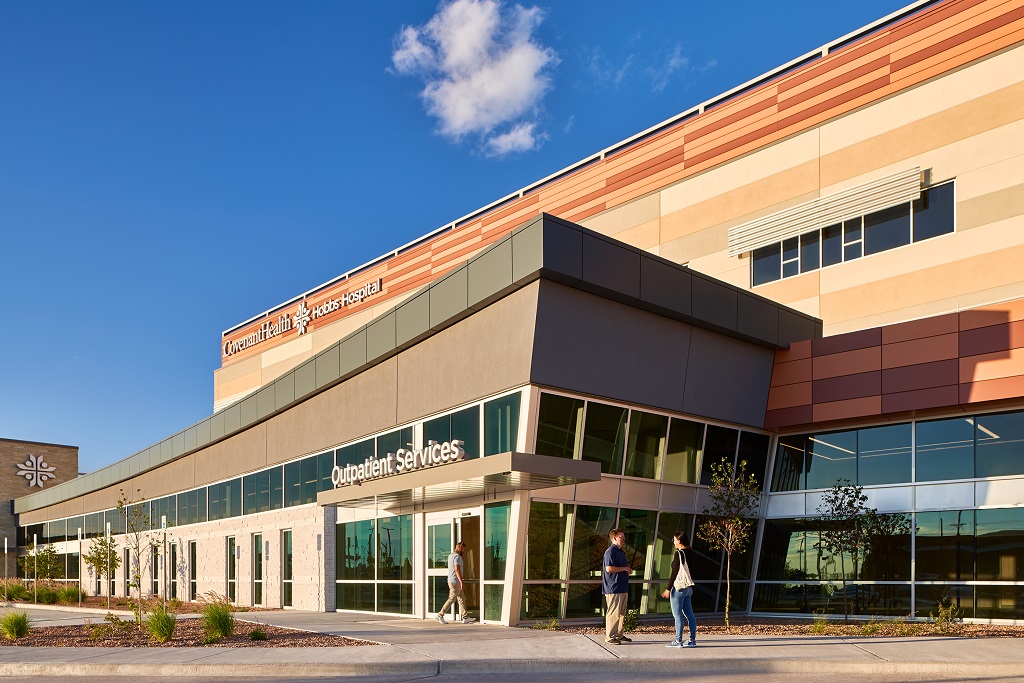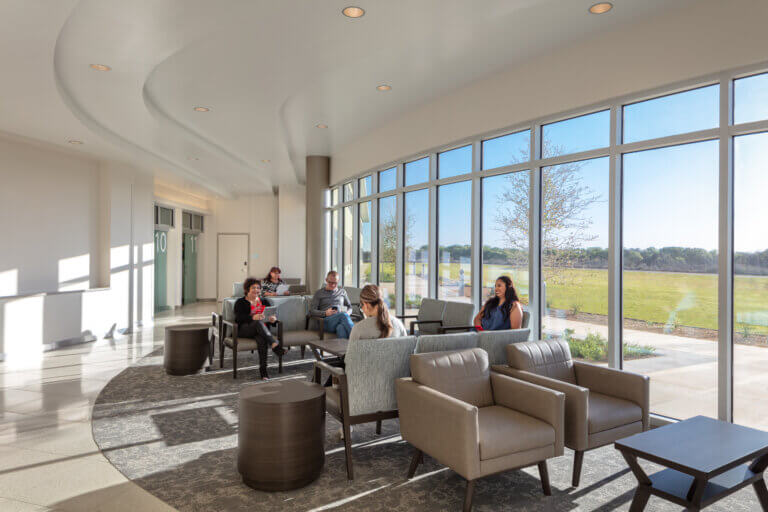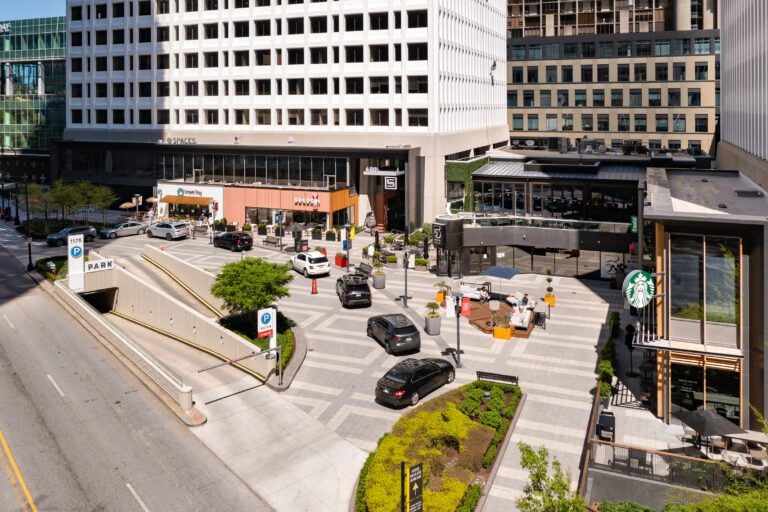
As the nation’s population shifts towards the sunbelt states, the need for healthcare follows. With limited resources in the southeastern New Mexico region, residents of Hobbs were faced with traveling two hours east, crossing state lines into Texas to receive care. The Covenant Hospital Hobbs is a solution for that need. The new hospital is a 109,000-square-foot, three-story acute care 60-bed facility that includes a patient tower, four operating rooms, imaging, lab, emergency department, intensive care unit, and dedicated women’s center offering labor & delivery, obstetrics, and mammography services. This new facility replaces the existing regional medical center to become the area’s largest hospital servicing the surrounding community.
On Rocky Ground
Site conditions in eastern New Mexico and the panhandle of Texas involve caliche rock, a sedimentary rock or hardened natural cement of calcium carbonate that binds other materials—such as gravel, sand, clay, and silt, generally found in arid regions where rainfall is less than 26 inches per year. Building on a 27-acre site atop this material was a monumental task that included on-site excavation. Hospital construction requires the installation of numerous, complex utility connections. Getting those utilities to the site first required breaking up the caliche rock — no easy task. In some spots, the utilities that would feed the hospital were located 17 feet underground, but an excavator alone could not punch through the rock. Our team dug thick trenches using a hydraulic hammer hoe to break up the rock, install the utilities and cover it back up. We had no way of knowing exactly how deep the rock was until crews started digging. And because of the size of the site, the rock depths fluctuated significantly, some being a foot deep and others five to six feet deep. Because of these challenging site conditions and caliche rock, the utility installations on this project took twice as long as they normally would.
The building’s concrete footings were designed to bear directly on a caliche rock bed. However, during excavation, our team discovered that for about one-fourth of the footings, the layer of caliche rock underneath started much deeper than anticipated, meaning there was a gap between the footing and the rock that was intended to support it. The team worked closely with the geotechnical engineer to come up with a solution and redesign the affected foundations during construction. The solution was to pour concrete to fill the space between the rock and the bottom of the footing. At the end of this process, our team was left with large chunks of caliche rock and huge trenches to fill. The project team decided to crush and reuse the rock as a sustainable alternative to hauling in new material. Crews set up processing equipment on site to finely crush the rock to fill the trenches.
Watch this time lapse of Covenant Health Hobbs Hospital’s construction.
Planning Around What We Can’t Predict
In addition to New Mexico’s terrain, the region also has a wide variety of weather including hail, dust storms, and snow – a lot of snow. On the first day of groundbreaking, a foot of snow fell. One week later – another six inches. These weather patterns forced weather delays and threatened the project’s schedule. In addition, our team had to strategize to overcome industry-wide shortages in skilled labor and material. Despite these scheduling challenges, this hospital, and the much-needed healthcare services it would provide, needed to be completed as soon as possible. Our healthcare experts understand that there are always factors you won’t be able to predict, so they plan for every project detail they can control and build time and efficiency into the schedule as a safeguard. On the Hobbs Hospital project, our preconstruction team worked closely with our entire project team to coordinate, plan, and strategize. Because of this, from the day we were awarded the project, work began four weeks later. But even the most precise planning can’t predict the weather. Our detailed preconstruction process and other proactive strategies proved to be invaluable.
Unprecedented supply-chain slowdowns made materials more expensive and harder to come by than our teams have ever experienced. Steel prices rose by 10% in the four weeks between winning the job and starting construction. Had our team waited three or four months to place orders, they would have more than likely seen a 20% increase in pricing. The potential cost savings were significant considering more than 760 tons of steel and nearly a half-million pounds of rebar were used to build the hospital. To prevent the delays, our steel trade partners worked seven days a week for four to five weeks to make up time in the schedule. They ended up beating their deadlines three times which lead to topping out a month early, only eight months after groundbreaking.
To combat other material price increases and delays, our team locked in orders early with suppliers. Electrical panels and gear were the main material delay coming out of Mexico. They arrived six months late, which had a significant impact on the 850,000 feet of electrical wiring and 250,000 feet of conduit that supplied the project. To save time, the medical gas and MEP fittings were prefabricated in a lay down yard on site instead of installing the systems inside of rooms. Roofing manufacturers also faced six-month delays for materials. The team was able to cut those delays in half by mixing and matching different products which performed and looked the same.
Building Up a Work Force
Hobbs has a population of about 40,000 people, with the nearest towns being Lubbock, TX, and Carlsbad, NM. The hospital’s remote, rural location made hiring local trade partners difficult, and almost nearly impossible. In fact, 80-90% of the trade partners on this project traveled in from across the country. Many experienced trades and large companies were either booked or unwilling to travel the significant distance required. Our team worked diligently to seek out talent in a wide range of locations to appropriately staff this project with skilled labor. The only caveat was, many of the trades didn’t have experience with our processes, like pull planning, and others didn’t have the required certifications for this job. Our team trained our trade partners in pull planning because we know it increases value and efficiency. We also worked with several companies to get certified with specific certifications required for this project.
With the population of Hobbs, New Mexico growing 20% in the last decade, the need for modern healthcare in the region was long overdue. Our team faced significant challenges, unforeseen and even unprecedented. Our project team was able to rely on proven preconstruction and planning processes to reduce the negative impact to the project schedule, while also applying creative solutions to improve efficiency and get the project back on schedule — even delivering some milestones ahead of schedule. With this new facility, people in and around Hobbs can receive proper medical care without having to leave their home state.

